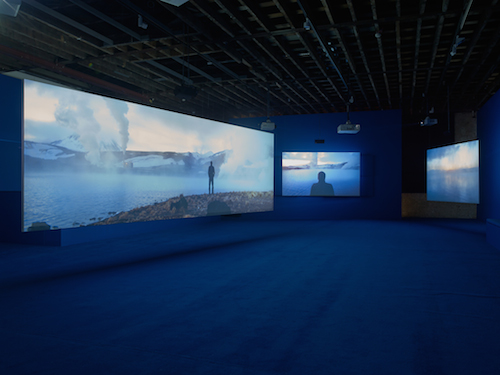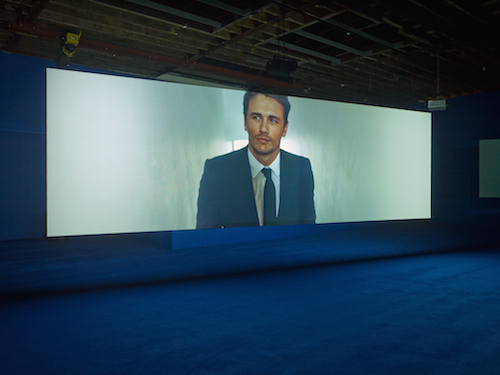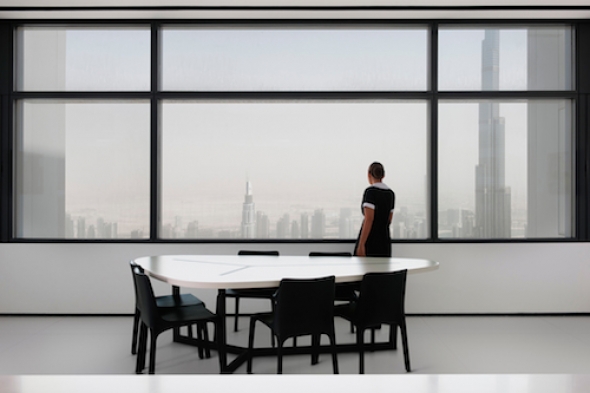The Maid and the Money-Form
Capital is going on around us all the time and yet, like gravity, we cannot see it except in its effects. A promising hypothesis, but Isaac Julien’s glossy video piece, Playtime, only reiterates the clichés of crisis cinema, says Alberto Toscano
The Mirror of Non-Production
More than a quarter of a century has lapsed since Fredric Jameson tried both to identify and incite the 'desire called cognitive mapping'.[i] Even an infrequent acquaintance with biennales and white cubes, not to mention the art press, offers a welter of anecdotal evidence that this desire has not in the least been quenched. Capital may be the invisible logic structuring our daily miseries, but it is also everywhere on display, especially in the shape of works that thematise its representability (and the limits thereto) in a context of crisis. In Isaac Julien's Playtime, art's moment of capital can be judged to have reached a kind of crystallisation, which doubles as a record of exhaustion and redundancy; a reflection of times in which a pall of uncertainty shadows the imperative of accumulation.
Doubles are ubiquitous in the seven screen feature-length installation, shown at the Victoria Miro gallery from 24 January to 1 March. Not only are images relayed and displaced across the projection screens, but faces and gazes are often cross-cut by reflecting surfaces, while the entire piece is suffused by an effulgent glossiness, a grit-less visual field familiar from advertising, nature documentaries and the aesthetics of finance itself. Yet these are not the materialist mirrors that Louis Althusser found in the work of Leonardo Cremonini, surfaces of mis-recognition, delay and over-identification, which allowed the Italian artist to 'paint the real abstract', thereby thwarting any identification of materialism with the theory of reflection.[ii]
Neither are these spaces – like the preternaturally speckless counter-tops we see a Filipina domestic stoically polishing in Playtime's Dubai episode – the uncanny habitats of an alien modernity, the like of which Jacques Tati traversed in the 1967 film from which Julien borrows his title. Notwithstanding the inspiration supposedly drawn from Eisenstein's cinematographic 'libretto' for Das Kapital, Julien does not film the real abstract; instead of representing capital, Playtime merely re-presents it.[iii] This failing is rendered all the more acute by the fact that at Victoria Miro we enter the fictional superstructure of Playtime via the discursive base of Kapital, a filmed conversation with David Harvey on the topic of capital's visibility, which is interspersed with footage of a traders' riot in the city (reminiscent of Kanye West and Jay-Z's No Church in the Wild, if considerably less compelling) and the now ineluctable shots of LED ticker tape and server banks.
Kapital is presented on two screens, in a manner more distracting than dialectical, and there is a further doubling in that the audience at Victoria Miro watch another audience watch Harvey and Julien's talk. This select public is composed among others of Paul Gilroy, Colin MacCabe, and the late Stuart Hall, all of whom pose somewhat foreseeable if partly warranted challenges to Harvey's unalloyed faith in classical Marxism, giving the proceedings a rather early-’90s vibe, despite the topicality of crisis (MacCabe's question, as to why the renascence of Marxian analysis has been unaccompanied by a reprise of socialist politics goes unanswered). It is difficult, especially when the conversation turns to the composition of the contemporary working classes, not to feel that the loop between the art world and academia, however radical, is uncomfortably narrow.
A phrase by Harvey serves as the leitmotiv for both works (and is voiced by one of the characters in the film-installation): capital is like gravity, invisible, only discernible through theoretical abstraction, and yet tangibly present in its effects. Yet as you ascend from the brightly lit ground floor into the cavernous carpeted twilight of Playtime, the potential promise of this axiom comes unravelled. What we encounter instead is a kind of inventory of the impasses which increasingly confront the theory and practice of 'representing capital'.
Cherchez la Femme (de Chambre)
Harvey's analogy of gravity is curiously disregarded in Julien's own installation. Where Eisenstein's gambit was to transpose Marx's method into film, by articulating, through montage, the affective dimension of capital's effects with its invisible, abstract processes, Julien resorts, in what does not appear an ironic or dialectical gesture, to repeating the representational clichés through which we typify capitalism. The conjuncture of financialised capital and crisis does not call forth any true formal innovations, any ruptures in our perceptual habits and visual forms.
The abundance of mirrors and doublings seems merely to connote, statically, capitalism's spectrality. Landscape, as in popular documentaries on the financial crisis such as Inside Job (which like Playtime travels to post-crisis Iceland), becomes a site of sublime contemplation, a static Other to capital, not the uneven battlefield of a production of nature and society – Caspar David Friedrich in the age of Goldman Sachs.

Image: Isaac Julien, Playtime, 2014
Playtime is organised around highly stylised 'portraits' of a set of archetypical figures – the Art Dealer, the Bankrupt Artist, the Domestic Worker, the Auctioneer, the Hedge Fund Manager. The personifications of capital are more dramatic ciphers of occupations than figures who may render a specifically filmic insight into how capital turns its subjects into bearers of anonymous processes, ventriloquised by abstraction (with the exception of the real auctioneer, whose manic panegyric to his craft carries a weird allure). They do not, as a Lukácsian realism might propose, generate cognitively and politically revealing types; nor, as in effective satire or caricature, do they effectively deploy a method of exaggeration. Indeed, when the characters, mostly alone or in pairs, pacing the voided spaces of finance, foreclosure, or art, turn and speak to the camera, their social ventriloquism is more reminiscent of the wooden asides peppering recent crisis films like The Bank, Margin Call, Le Capital, Krach, or Arbitrage, than of the magnificently psychotic monologues of Ned Beatty in Network or Hume Cronyn in Rollover (Scorsese's The Wolf of Wall Street ironically signals its abdication of cognitive mapping with Leonardo Di Caprio interrupting his 'explanations' of finance, to resume the litany of sexual and chemical excess that fuelled his character's accumulative strategy).
Most symptomatically, and in keeping with contemporary melodramas of global finitude and economic anxiety like Babel (dir. Alejandro Gonzalés Iñarritu, 2006) and Mammoth (dir. Lukas Moodysson, 2009), class and exploitation are metonymically embodied in the maid, a woman of colour, in this case a Filipina trapped in the postmodern wastes of Dubai – here represented, as has already been noted, through the most resilient visual clichés of Orientalism, from the immaculate undulating desert through which she contemplatively strides to the apparently vacant skyscrapers, with the accompaniment of vaguely Arabic music.[iv]
That Julien would note his desire to base his characters on people he's met, and their experiences of the crisis, is revealing – as in those Hollywood films, it's as if domestic workers have become the only conduit for a transnational elite to access the lived reality of exploitation. None of the workers who build Dubai are visible in Julien's tableaus, just as any proletarian labour other than domestic is effectively absent from Iñarritu's California or Moodysson's New York City. There would be nothing to object to sustained reflection on the closure of the 'art world', on its disjunction from the predicaments of everyday life and labour (we could think here of Godard's gesture, refusing to 'go to Vietnam' in the 1970s, filming himself in Loin du Vietnam on a Parisian roof with an enormous camera ruminating the aporias of solidarity), but there is more indulgence than reflexivity in this mise-en-scène of the crisis. Following the maid in this way – as a lone individual adrift in the Gulf dystopia – means not following the money, nor indeed articulating how crisis is a collective experience (cognitive mapping, as Jameson once quipped, being another name for class consciousness). Nor does the drama of the Icelandic photographer, haunting his own unfinished modernist home – his life fractured and suspended by the crash, architectural hubris giving way to geometric ruin – really serve as more than a dispatch of déclassement from strata whose experience it is hard to treat as emblematic.
Julien's film ultimately reiterates a widespread cognitive and aesthetic impasse in what concerns giving form to capital, crisis and contradiction. It does so with glossy elegance – itself a connotation, as he recognises, of the kind of art that requires much... capital, as the presence of Hollywood stars James Franco and Maggie Cheung further underscores. What is writ large, in this depopulated world which resembles nothing so much as those neutron-bomb car advert fantasies of digitised nature, is the seemingly panoramic but in fact extremely parochial 'view' of capital afforded by the habitus of the metropolitan 'art world' (one that shares so much with the visual culture of contemporary commerce and entertainment).

Image: Isaac Julien, Playtime, 2014
In Playtime, all three elements of one possible definition of capital – as a social relation of production – are screened out. The de-socialisation of the economy is relayed by the fact that the seven-screen installation is more or less devoid of true montage, relying on juxtaposition, rhythmic alternation of shots, and the continuity of ambient soundtracks, but creating no flashes of insight, no clashes of form and content, no unexpected connections, no break with the smooth empty time of financialised capital, here 'represented' by data banks, flashing stock displays, and empty trading floors. Tellingly, on my visit to Victoria Miro the sizeable audience all sat dutifully on the perimeter of the carpeted floor, craning heads and scanning eyes quietly labouring to compose a familiar cinematic experience, no one really compelled to move around – fearing to interrupt the others' enjoyment, perhaps, but also, one imagines, because Playtime doesn't call for that kind of work, of montage and perambulation, from the viewer.
What Julien's Playtime finally demonstrates is that the representation of capital can also turn into one of the 'mythologies' of our time. The more we are bewitched by 'the' crisis and financialisation, the more we risk treating a capitalist aesthetic as an aesthetic of capital, mistaking the redundancy of re-presentation for the complex seeing that our times demand. To echo Brecht, as our reality continues to 'slip into the domain of the functional', a tracking shot past a stack of servers running algorithms, or the mere ventriloquising of capital's ceaseless chatter, is unlikely to reveal any more about the institutions of contemporary finance than a photograph of the Krupp works or the AEG could tell the spectator of the 1930s about those pillars of German militarism. 'The reification of human relations … no longer discloses these relations. So there is indeed “something to construct”, something “artificial”, “invented”.'[v] To make such constructions possible, it will be necessary to take a far greater distance from capital's ubiquitous clichés than works 'about' the crisis and finance have done hitherto, to leave the echo chambers in which the language of commodities natters incessantly. The 'art world' is possibly not the best place to start.
Alberto Toscano <sos01at AT gold.ac.uk> teaches at Goldsmiths, University of London. He sits on the editorial board of the journal Historical Materialism and edits the Italian List for Seagull Books. He is the author of Fanaticism: On the Uses of an Idea (London: Verso, 2010), and is currently completing a book on the aesthetics of capital with Jeff Kinkle, Cartographies of the Absolute, forthcoming from Zero Books. Blog at:
http://cartographiesoftheabsolute.wordpress.com/
Isaac Julien's Playtime was at Victoria Miro Gallery, London from 24 January to 1 March 2014
Footnotes
[i] Fredric Jameson, 'Cognitive Mapping', in Marxism and the Interpretation of Culture, ed. C. Nelson and L. Grossberg (Champaign: University of Illinois Press, 1988).
[ii] Louis Althusser, ‘Cremonini, Painter of the Abstract’, in Lenin and Philosophy and Other Essays, trans. B. Brewster (New York: Monthly Review, 1971).
[iii] Isaac Julien, Riot (New York: Museum of Modern Art, 2013).
[iv] 'It is unclear whether these sequences are intended to be ironic. Nevertheless, they induce one thing: a sense of Arab kitsch—a view of the Arab world told through mediated, distanced eyes. Indeed, this scene differs little from the innumerable portrayals of Arab sites to be found in hegemonic culture, where the men are abstract, oppressive figures, the women forced into labor, and the visual and sonic tapestry is one that evokes Orientalism'. Omar Kholeif, 'Isaac Julien's “Playtime”', art agenda, http://art-agenda.com/reviews/isaac-julien%E2%80%99s-%E2%80%9Cplaytime%E2%80%9D/ . See also William S. Smith, 'Isaac Julien', Art in America, http://www.artinamericamagazine.com/reviews/isaac-julien/
[v] Bertolt Brecht, 'The Threepenny Trial: A Sociological Experiment', in German Essays on Film, ed. R. McCormick and A. Guenther-Pal (New York: Continuum, 2004).
Mute Books Orders
For Mute Books distribution contact Anagram Books
contact@anagrambooks.com
For online purchases visit anagrambooks.com







